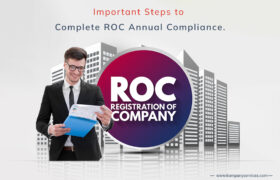The Limited Liability Partnership registration framework has sparked widespread interest among entrepreneurs looking to collaborate on company activities with few regulatory concerns. LLPs, which combine the benefits of limited liability for partners with operational freedom, provide an alternative to traditional partnership firms and private limited companies. In this article, we will look at the procedure for LLP registration in India.
LLP Registration Procedure in India
The LLP Registration process is completely online and done on the MCA’s official website. The application form for this purpose is web-based and accessible through the MCA website. Furthermore, all documents can be uploaded online with the form to finish the process. The specific measures to take are outlined below.
Step 1: Obtain the DPIN of each Designated Partner.
The Designated Partners in an LLP are in charge of overseeing its management and making critical decisions on subjects other than day-to-day business operations. Hence, their function in the establishment and incorporation of the LLP is extremely crucial. Before you begin the LLP registration procedure, ensure that all current designated partners have received their DPINs. DPIN, or Designated Partners Identification Number, is a unique number assigned by the MCA to each designated partner of an LLP. To obtain a DPIN, submit an application to the Ministry of Corporate Affairs in form DIR3.
Step 2: Obtain the DSC of all Partners.
The form for LLP incorporation is web-based and must be signed with the permitted designated partner’s digital signature. For this purpose, any two selected partners may be authorised by all of the LLP’s partners. Furthermore, the documents uploaded with the form may require authentication from all partners. As a result, it is advised that all partners get the specified class of Digital Signature Certificate (DSC) in advance. This would provide a simple and hassle-free LLP registration process.
Step 3: Name Approval for the LLP
The name of your LLP must follow the standards outlined in numerous statutes such as the Companies Act, the Trademark Act, and the Names and Emblems Act. In essence, your LLP’s name must be unique, innovative, and reflect your business activity. Choosing names that are identical to already registered companies, LLPs, or trademarks should be avoided. In addition, because LLP is a privately owned business, the name must not contain phrases implying government patronage. The name of your LLP must be reserved with the ROC, which requires you to file the RUN-LLP form. You may offer two names per application, which will be reviewed by the registry. The name that has been determined to be valid will be reserved or approved for your LLP. The ROC also allows for two resubmissions if the proposed names are invalid. Once the name has been authorised, the LLP is granted a name approval letter that is only valid for 90 days. The applicant must complete the remainder of the LLP Registration process within these 90 days exclusively.
Step 4: Apply for LLP registration.
The next stage in the LLP registration process is to file the application. The application can be accessible through the Ministry of Corporate Affairs’ official website. The names, addresses, and capital contributions of all partners must be supplied, as well as the names and DPINs of all designated partners, the name and registration address of the LLP, and other relevant information. Finally, the authorised designated partner must sign the application with his digital signature certificate, which will then be validated by a practicing Company Secretary.
Step 5: Make the payment and retain the SRN.
After entering the form, you will be instantly routed to the payment page. Make a payment. A challan will be issued, along with a Service Request Number (SRN). Keep the challan safe for future reference. Once the form has been approved by the appropriate Ministry official, you will receive an email and the form’s status will change to Approved.
Step 6: Issue the Certificate of Incorporation
The submitted application will subsequently be reviewed by the ROC. If ROC is satisfied that your application was filed correctly, with all of the necessary facts and documentation, he or she will approve it and register your LLP. As irrefutable proof of such registration, the ROC will issue a Certificate of Registration in the name of the LLP. The certificate can be downloaded directly from the MCA website.
Step 7: Submit the LLP Agreement.
An LLP, like any other partnership, is founded on a deed or agreement signed by all of the partners. This agreement must be stamped by a public notary, and the necessary stamp duty must be paid. LLP Agreements must be presented to the Registrar of Companies within 30 days of the LLP’s incorporation date.
The LLP Registration process in India is a critical step for firms seeking the benefits of a traditional partnership structure, such as limited liability protection, legal recognition, and operational flexibility. This totally online process entails getting DPINs and DSCs for specified partners, choosing a unique name, filing the application with all required papers, paying the application fee, and finally receiving the Certificate of Incorporation. Registering an LLP not only gives the business a legal name, but it also allows for easier finance, credit, and business opportunities. As a result, understanding and following the LLP Registration process is critical for all aspiring entrepreneurs wishing to establish their businesses in India.




